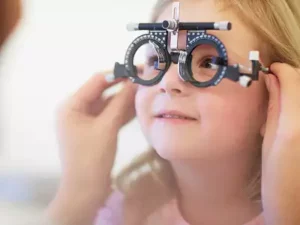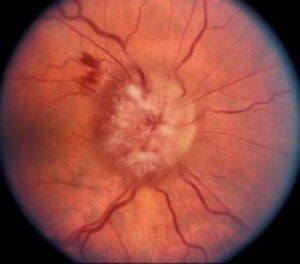Eye condition that over time destroys central vision.
It is common in people over 60 years of age.
The macula helps us see fine details in vision and provides us with clear vision day and night.
There are two types of age-related macular degeneration: dry and wet.
Dry AMD occurs when the blood vessels under the macula become thin, brittle, and small yellow deposits form.
Wet AMD, abnormal and very fragile new blood vessels appear under the macula. These blood vessels leak blood and fluid. This type of macular degeneration causes most of the vision loss associated with the disease.
Medicine still does not know exactly what causes this disease. However, we leave you some risk factors:
- Family history of the disease
- Being white
- Smoking
- High fat diet
- To be a woman
When the disease begins, the symptoms are silent and are more noticeable when macular degeneration has advanced enough to affect central vision. A blurry spot in the center of vision gradually becomes larger and darker.
Dry AMD Symptoms
Objects in central vision often appear dull and distorted, and colors appear washed out. The patient with MSD has difficulty reading or seeing other details, but can see well enough to walk or perform most daily activities.
In the more advanced stages, the person may not be able to recognize faces until they are close.
Wet AMD Symptoms
Straight lines appear crooked and wavy.
There may be a black spot in the center of your vision that will get larger over time.
If you have severe wet or dry AMD, no treatment can restore vision. However, a combination of certain vitamins, antioxidants, and zinc may prevent the disease from worsening. Although this will not restore vision that has already been lost.
Lutein and zeaxanthin, substances found in green leafy vegetables, may also lower the risk of age-related macular degeneration.
Early detection of changes in central vision is important, as the sooner treatment is done, the better the prognosis. Early detection leads to timely treatment and often a better clinical outcome.
The best way to detect changes is by self-testing at home with an Amsler grid, you can print one off the Internet. Assess each eye individually using reading glasses. If the lines look wavy, make an appointment with your ophthalmologist right away.
Forms of prevention:
- Do not smoke tobacco.
- Eat a healthy diet rich in fruits, vegetables and low in fat.
- Get regular exercise.
- Maintain a healthy weight.
Visit your trusted ophthalmologist regularly to perform dilation exams and be able to evaluate your eyes in depth.





